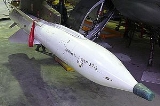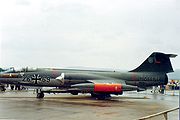
AS.34 Kormoran
Encyclopedia
The AS.34 Kormoran is a German-produced Anti-ship missile
. The Kormoran (cormorant) uses an inertial guidance system for the midcourse phase, switching to active radar homing during the terminal attack phase. It carries a 165 kg (363 lb) delay-fused warhead, designed for 90mm of penetration prior to detonation. The maximum range is 23 km (~14 miles).
 Development of the Kormoran started in 1962, being taken over by Messerschmitt-Bolkow-Blohm (now a part of EADS
Development of the Kormoran started in 1962, being taken over by Messerschmitt-Bolkow-Blohm (now a part of EADS
) in 1967. The missile was originally designed for anti-shipping
roles in coastal waters, although it retains a secondary land-attack capability as well. It is currently deployed on the Panavia Tornado
. 350 Kormoran 1s were produced.
The AS.34 Kormoran 2 is an improved version of the AS.34 Kormoran 1. Development was started in 1983, with first flight and firing trials taking place in early 1986. The missile features an improved warhead, all-digital electronics, improved active radar seeker, increased ECM-resistance, a stronger booster rocket
, a longer range, improved automated target selection, multiple launch capability, and an increased resistance to countermeasures.
 While still using the same basic airframe as Kormoran 1, the Kormoran 2 has a greater range of 35km (21.7 miles) and a heavier 220 kg (485 lb) warhead.
While still using the same basic airframe as Kormoran 1, the Kormoran 2 has a greater range of 35km (21.7 miles) and a heavier 220 kg (485 lb) warhead.
Testing ended in 1987, and the missile entered service with the German Navy
in 1991. Approximately 140 missiles were produced for Germany. The missile is now in service with the German Luftwaffe
and Italian Air Force
.

Anti-ship missile
Anti-ship missiles are guided missiles that are designed for use against ships and large boats. Most anti-ship missiles are of the sea-skimming type, many use a combination of inertial guidance and radar homing...
. The Kormoran (cormorant) uses an inertial guidance system for the midcourse phase, switching to active radar homing during the terminal attack phase. It carries a 165 kg (363 lb) delay-fused warhead, designed for 90mm of penetration prior to detonation. The maximum range is 23 km (~14 miles).

EADS
The European Aeronautic Defence and Space Company N.V. is a global pan-European aerospace and defence corporation and a leading defence and military contractor worldwide...
) in 1967. The missile was originally designed for anti-shipping
Anti-Surface Warfare
Anti-surface warfare is a type of naval warfare directed against surface combatants. More generally, it is any weapons, sensors, or operations intended to attack or limit the effectiveness of an adversary's surface ships....
roles in coastal waters, although it retains a secondary land-attack capability as well. It is currently deployed on the Panavia Tornado
Panavia Tornado
The Panavia Tornado is a family of twin-engine, variable-sweep wing combat aircraft, which was jointly developed and manufactured by the United Kingdom, West Germany and Italy...
. 350 Kormoran 1s were produced.
The AS.34 Kormoran 2 is an improved version of the AS.34 Kormoran 1. Development was started in 1983, with first flight and firing trials taking place in early 1986. The missile features an improved warhead, all-digital electronics, improved active radar seeker, increased ECM-resistance, a stronger booster rocket
Booster rocket
A booster rocket is either the first stage of a multi-stage launch vehicle, or else a strap-on rocket used to augment the core launch vehicle's takeoff thrust and payload capability. Boosters are generally necessary to launch spacecraft into Earth orbit or beyond...
, a longer range, improved automated target selection, multiple launch capability, and an increased resistance to countermeasures.

Testing ended in 1987, and the missile entered service with the German Navy
German Navy
The German Navy is the navy of Germany and is part of the unified Bundeswehr .The German Navy traces its roots back to the Imperial Fleet of the revolutionary era of 1848 – 52 and more directly to the Prussian Navy, which later evolved into the Northern German Federal Navy...
in 1991. Approximately 140 missiles were produced for Germany. The missile is now in service with the German Luftwaffe
Luftwaffe
Luftwaffe is a generic German term for an air force. It is also the official name for two of the four historic German air forces, the Wehrmacht air arm founded in 1935 and disbanded in 1946; and the current Bundeswehr air arm founded in 1956....
and Italian Air Force
Italian Air Force
The Italian Air Force has gone under different names in different periods:*Regia Aeronautica , from 1923 to June 1946*Aeronautica Nazionale Repubblicana, the air force of Italian Social Republic during World War II...
.
Specifications

- Name: AS.34 Kormoran 1/2
- Weight: 600/630 kg
- Length: 4,40 m
- Range: 23/35 km
- Warhead: 165/220 kg
- Guidance: INS/active radar homingActive radar homingActive radar homing is a missile guidance method in which a guided missile contains a radar transceiver and the electronics necessary for it to find and track its target autonomously...

